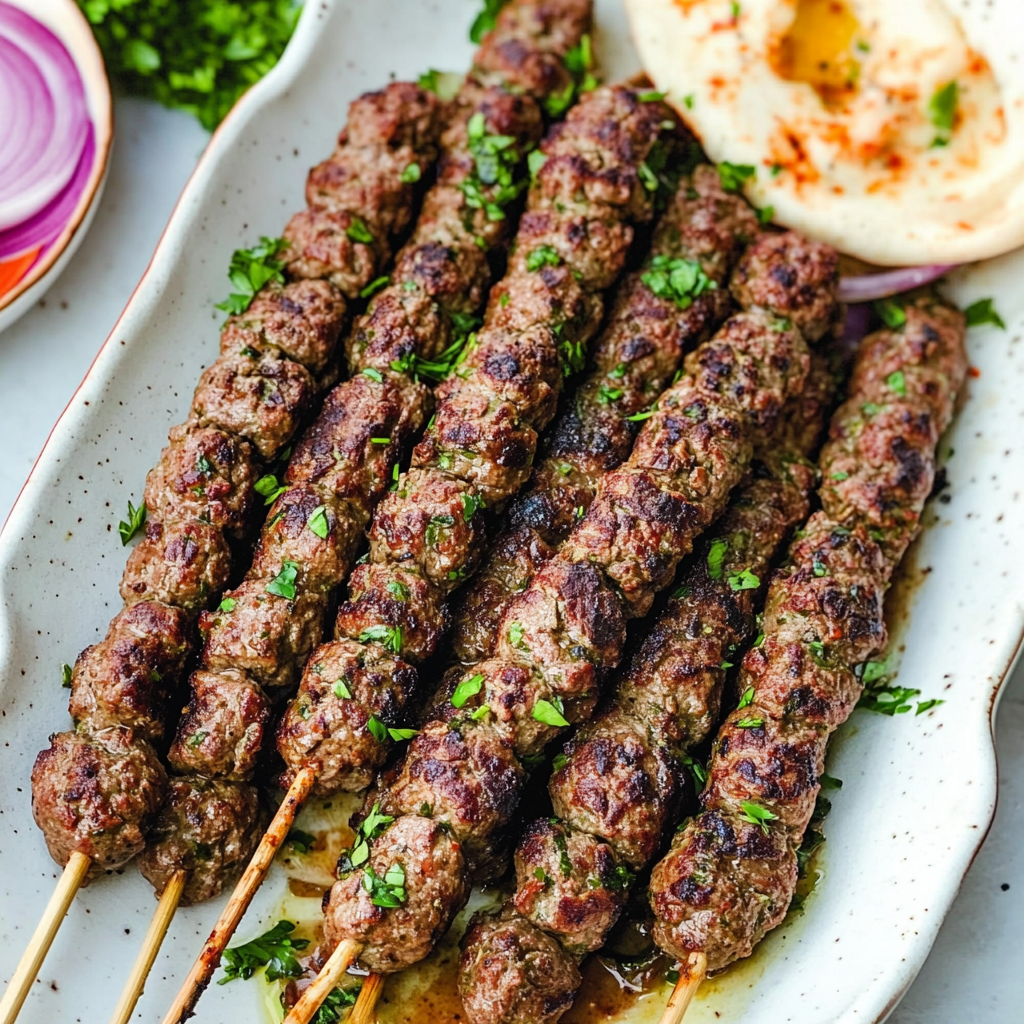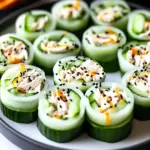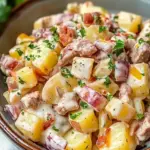These Kafta Kebabs are a delightful blend of lean ground beef, fresh parsley, and aromatic spices, grilled to perfection. The smoky char from the grill enhances the rich flavors, making each bite a savory experience.
Traditionally served with accompaniments like hummus, tabbouleh, or wrapped in pita bread, these kebabs are versatile and can be enjoyed in various ways. Their juicy texture and flavorful profile make them a favorite at gatherings and family meals.
Full Recipe
Ingredients:
-
1 kg (2.2 lbs) lean ground beef (20% fat recommended)
-
1 medium yellow onion, quartered
-
1 cup fresh parsley, finely chopped (discard stems)
-
1 tablespoon salt
-
½ teaspoon freshly ground black pepper
-
½ teaspoon ground allspice
-
½ teaspoon cayenne pepper or chili flakes (optional)
-
10–12 wooden or metal skewers (if using wooden skewers, soak in water for 30 minutes)
Directions:
-
Prepare the Onion and Parsley: In a food processor, pulse the quartered onion and chopped parsley until finely minced. This step helps release excess moisture from the vegetables, preventing the meat mixture from becoming too wet.
-
Combine Ingredients: In a large mixing bowl, combine the ground beef with the minced onion and parsley mixture. Add salt, black pepper, allspice, and cayenne pepper (if using). Mix thoroughly by hand until the mixture is well combined and slightly sticky.
-
Shape the Kebabs: Divide the meat mixture into 10–12 equal portions. Wet your hands to prevent sticking, then mold each portion around a skewer, shaping it into a long, oval kebab about 1 to 1.5 inches thick. Ensure the meat is evenly distributed along the skewer.
-
Preheat the Grill: Preheat your grill to medium-high heat. If using a gas grill, brush the grates with a little oil to prevent sticking.
-
Grill the Kebabs: Place the skewers on the preheated grill. Grill for about 4 minutes on one side, then flip and grill for another 4 minutes, or until the meat is cooked through and has an internal temperature of 160°F (71°C).
-
Serve: Remove the kebabs from the grill and let them rest for a few minutes. Serve with accompaniments like hummus, tabbouleh, fattoush, or wrapped in warm pita bread.
Prep Time: 15 minutes
Cooking Time: 10 minutes
Total Time: 25 minutes
Kcal: Approximately 250 kcal per serving
Servings: 4–6 servings
Introduction to Kafta Kebabs
Kafta Kebabs are a celebrated dish across the Middle East, particularly in Lebanese, Syrian, Jordanian, and Palestinian cuisines. These grilled skewers are a mouthwatering blend of ground meat—commonly beef or lamb—mixed with chopped onions, fresh herbs like parsley, and a well-balanced mix of aromatic spices. Kafta is a cornerstone of Levantine street food, often featured at family gatherings, festive occasions, and weeknight dinners.
These kebabs are not only delicious, but they also reflect the essence of Middle Eastern hospitality and culinary tradition. Whether served in a warm pita wrap or plated alongside classic side dishes like hummus, baba ghanoush, and tabbouleh, Kafta Kebabs are a testament to the power of simple ingredients and time-honored techniques.
Cultural and Historical Background
The name “kafta” (or “kofta,” depending on regional spelling) originates from Persian, with the word “kuftan” meaning “to grind” or “pound.” The dish spread throughout the Middle East, Central Asia, and the Indian subcontinent, where it evolved into various forms, from skewered meatballs to saucy braised dishes. In Lebanon, kafta took on its now-familiar shape as oblong kebabs grilled on skewers or cooked in the oven with tomatoes and potatoes.
Kafta is more than just food—it’s a cultural bridge that connects generations and geographies. It’s common to see large platters of kafta at family feasts and celebrations. In many households, preparing kafta is a collaborative effort, often involving parents, grandparents, and children forming patties or threading the mixture onto skewers.
Key Flavors and Ingredients
Though the ingredients in Kafta Kebabs are humble, the flavor they produce is anything but. The ground beef used in the recipe benefits from having a bit of fat—around 20%—to keep the kebabs juicy and flavorful during grilling. Fresh parsley and onions give the mixture a vibrant, slightly sweet flavor, while spices like black pepper, allspice, and occasionally a touch of cayenne or chili flakes provide depth and a subtle kick.
What sets Lebanese kafta apart from similar kebabs in other cultures is its balance of herbs and spices. It avoids being overly spicy or heavily seasoned, allowing the natural flavor of the meat and herbs to shine. This delicate flavor profile makes kafta incredibly versatile and appealing to a wide range of palates.
Grilling Techniques and Cooking Tips
While the classic method involves grilling the kebabs over an open flame or on a barbecue, kafta can also be baked or pan-fried if a grill isn’t available. The key to juicy kafta is not to overcook it. Cooking the kebabs just until they’re done keeps them tender and moist.
If you’re using wooden skewers, soaking them in water for 30 minutes before grilling helps prevent burning. For best results, shape the kebabs evenly and avoid making them too thick, which ensures even cooking throughout. Many cooks also refrigerate the skewers for a short time before grilling to help them hold their shape and maintain moisture.
Another useful tip is to pulse the onion and parsley in a food processor to extract excess moisture. Squeezing out some of the liquid before mixing with the meat helps prevent the kafta from becoming too wet and falling apart during cooking.
Serving Suggestions and Pairings
Kafta Kebabs are incredibly versatile when it comes to serving options. They can be served as part of a larger mezze spread, alongside dips such as hummus, baba ghanoush, or labneh. They’re also perfect with fresh salads like fattoush or tabbouleh, or served over a bed of fluffy basmati or Lebanese rice with vermicelli.
Another classic way to enjoy kafta is wrapped in a warm pita with fresh vegetables, pickles, and a drizzle of tahini sauce or garlic sauce (toum). The contrast between the smoky, juicy meat and the fresh, tangy accompaniments makes for an irresistible meal.
Kafta also pairs beautifully with grilled vegetables such as zucchini, bell peppers, and eggplant. You can easily turn this dish into a complete dinner platter that balances protein, fiber, and healthy fats.
Nutritional Information and Dietary Adaptations
Kafta Kebabs are not only delicious but can also be part of a balanced and nutritious diet. Using lean beef or lamb keeps the fat content moderate, while fresh herbs and onions add antioxidants and other beneficial nutrients. Depending on how they are served, kafta can fit into a variety of dietary preferences, including low-carb, gluten-free, and paleo lifestyles.
For a lighter version, you can make kafta with ground chicken or turkey. Vegans can try plant-based versions using lentils, chickpeas, or textured vegetable protein (TVP) combined with similar spices and herbs.
To lower sodium, adjust the salt quantity or use a blend of salt-free seasoning with herbs like oregano, thyme, or mint for added flavor.
Why Kafta is a Family Favorite
Kafta Kebabs are a hit with both kids and adults. They’re easy to eat, packed with flavor, and customizable. Whether served on skewers or in a wrap, kafta appeals to even picky eaters and can be tailored to suit different spice levels or dietary restrictions.
For busy families, kafta is a practical option. You can prepare the mixture in advance and refrigerate it for up to a day before cooking. It also freezes well—simply shape the kebabs and freeze them raw, then cook straight from frozen when needed. This makes kafta a perfect meal prep option.
Tips for Making the Best Kafta at Home
-
Choose quality meat: Look for fresh, lean ground beef or lamb with some fat content for flavor.
-
Use fresh herbs: Parsley is essential. The fresher it is, the more vibrant the taste.
-
Avoid overmixing: Mix just until combined. Overworking the meat can result in tough kebabs.
-
Keep it moist, not wet: Remove excess liquid from the onion-parsley mixture to prevent soggy kebabs.
-
Preheat the grill: Make sure your grill or pan is hot before adding the skewers to get a nice sear.
-
Serve with dips: Don’t skip the sauces—tahini, garlic sauce, or even yogurt-based dressings take kafta to the next level.
Making Kafta Part of a Modern Meal Plan
As traditional as kafta is, it’s easy to incorporate into modern meal plans. You can meal prep a batch for the week and pair it with grains, roasted vegetables, or leafy greens for a quick lunch or dinner. Because kafta packs well, it’s also an excellent choice for work lunches or picnics.
Those following macro-friendly diets can portion kafta into precise servings, and the simple ingredient list makes it easy to track. You can make kafta bowls with quinoa or bulgur, pickled red onions, cherry tomatoes, and cucumber ribbons, dressed with a lemony olive oil vinaigrette.
Kafta’s adaptability makes it a go-to for people looking to eat healthier without sacrificing flavor. It’s also naturally free of processed ingredients and additives, aligning well with whole-food eating styles.
Conclusion
Kafta Kebabs are a classic Middle Eastern dish that brings together simple ingredients and bold flavors in a delicious, grill-friendly format. They are more than just skewers of meat—they are a celebration of family, heritage, and culinary craftsmanship. With their rich history, customizable nature, and irresistible taste, it’s easy to see why kafta remains a beloved staple in kitchens around the world.
Whether you’re hosting a summer barbecue, preparing a weeknight dinner, or looking for a healthy and satisfying meal option, Kafta Kebabs are an excellent choice. With just a few ingredients and minimal prep time, you can enjoy a dish that’s both rooted in tradition and endlessly adaptable to your personal taste and lifestyle.






